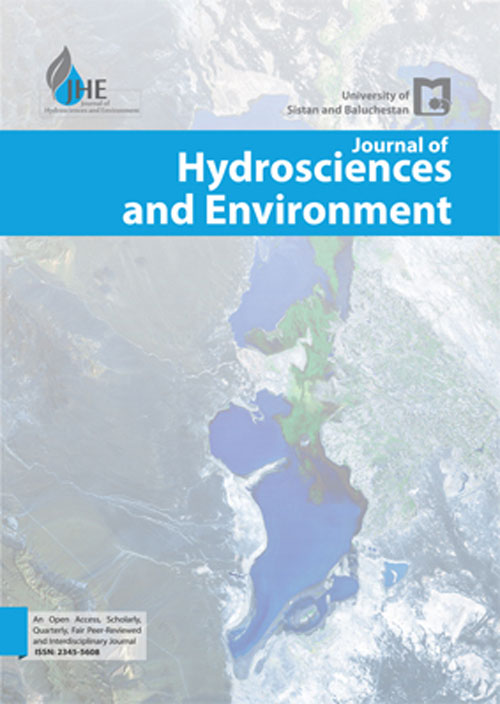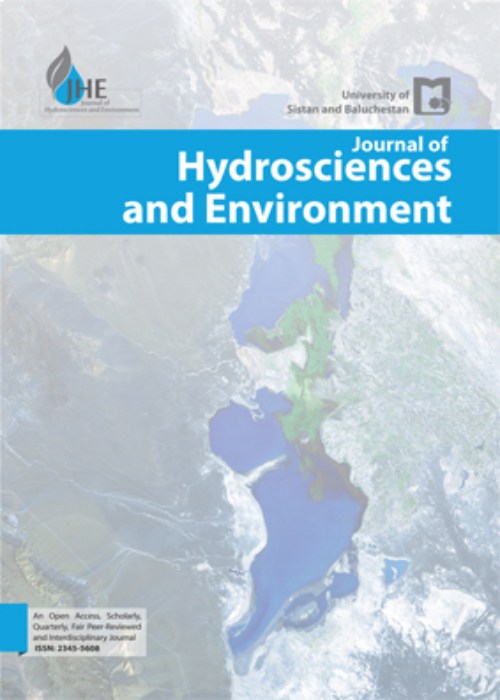فهرست مطالب

Journal of Hydrosciences and Environment
Volume:1 Issue: 2, Sep 2017
- تاریخ انتشار: 1396/06/23
- تعداد عناوین: 7
-
Pages 1-11
In arid and semi-arid regions of Iran as the rainfall is reduced and the population and the demand for food continue to grow, high-quality water consumption and the development of planting area increasingly gain importance. The present study was aimed to evaluate the economic benefits of the pressurized irrigation system in Ardabil Province, Iran by a survey methodology, production function, and farmers’ data for the growing season 2014-2015 (using a questionnaire). Results show that pressurized irrigation system not only reduces water consumption by as high as 17%, but it also optimizes the application of other production inputs and enhances the productivity of production inputs and water.
Keywords: Economic Benefits, Pressurized Irrigation, System Development, Ardabil Province -
Economic Assessment of Biodiversity Function of the Hamoon Wetland Ecosystem by Contingent ValuatiomPages 12-20
In the development process of the countries, the wetlands play a significant role in people’s well-being by providing the goods and services that are used directly and indirectly. Some examples of these goods include recreational use (as non-consumable values), harvested meat (as direct consumable values), carbon uptake, oxygen generation, water conservation, and soil retention (as indirect consumable values). In addition to consumption values, wetlands have other values too; i.e. the money paid by people to protect the wetlands for future use, for next generations and for their being, no matter if they are used or not used. These non-consumable values are called protection values, too. The present work estimated the value of goods and services of Hamoon wetland ecosystem in the form of biodiversity function in order to economically evaluate the drought damages to Hamoon wetland in 2015. The data needed to estimate the value of these functions were collected by a questionnaire. The biodiversity protection value of Hamoon wetland as the protection value of its forest ecosystem was estimated by contingent valuation method using the data collected from 450 people living in the rural areas surrounding the wetland. The results show that the value of protection of the Hamoon wetland biodiversity is 333.75 billion IRR and the expected WTP to protect its wildlife is 35542.74 IRR per family per year.
Keywords: Damage, drought, Hamoon Wetland, Economic Assessment -
Pages 21-33
The evolution of oil spilled in marine environments is affected by its spread, evaporation, emulsion, dissolution and dispersion in the water column. Although it has an environmental impact on marine ecosystems and affects determination of the spilled oil lifetime, vertical dispersion is of great importance; however, less attention has been paid to this complex phenomenon in comparison with other processes. This article is a critical review of the existing analytical relationships for oil dispersion calculation. The implementation of these formulae in numerical models is not straightforward. A comprehensive review of numerical oil dispersion models is presented with the advantages and disadvantages of each approach. In addition, experimental oil spill studies are reviewed and their obstacles are discussed. Analysis of experimental data cited in the literature has been carried out and variations in the oil concentration distribution in water bodies has been investigated. The current knowledge gaps and areas that require further investigation are identified and future research directions are proposed for in-depth assessment of vertical oil dispersion in the marine environment. Major areas of future study should focus on gradients of oil concentration by depth in the water column instead of overall penetrated oil mass in a water body. It is also suggested that advanced models use explicit physically-based formulations rather than empirical oil concentration relationships. It should be noted that selection of appropriate space and time intervals for sampling in experimental studies is required to form a proper understanding of the temporal and spatial oil concentration distribution in a water body.
Keywords: Marine Pollution, Oil Spill, Fate, Transport Model, Vertical Dispersion, Weathering processes -
Pages 34-45
Knowledge of the effective parameters and estimation of maximum scour depth around bridge piers has an important role in the safe design of bridges in rivers. With development of construction of structures, bridges with various geometries have been constructed such as inclined bridge piers group which has a complex scour process because of simultaneous effect of inclination of piers, foundation and sheltering of second piers. Therefore, most conventional approaches that are based on empirical method are unable to estimate scour dimension. One method to predict physical process whose effective parameters are related in a non-linear and complex manner is utilization of intelligent system. The aim of this research is to predict scour depth around the inclined bridge piers located on the rectangular foundation using optimized ANFIS parameters with GA, Matlab ANFIS and ANN with different hidden layers, activation function, and learning rules. Forty-eight sets of experimental data of scour around the inclined bridge piers were used for various flow condition foundation levels. To compare the results, R2 and RMSE were utilized. Analysis of results showed that Matlab ANFIS and ANN could predict the maximum scour depth with =0.976, RMSE=0.0530 and=0.99, RMSE=0.0359 at best configurations, respectively. Comparison of results indicated that optimization of ANFIS parameters improved the accuracy of prediction of desired parameters with=0.99, RMSE=0.0254.
Keywords: Scour depth, Inclined Pier Group, ANFIS, Genetic Algorithm, ANN -
Pages 46-54Scour simulation is a way to prevent a bridge against the possible major damages. In this study, local scouring around a cylindrical pier in non-cohesive bed sediment was simulated with the aid of Flow-3D model capabilities. A rectangular channel with 0.4 m width and 1.0 m length and a vertical cylindrical pier with diameter of 0.03 m and height of 0.3 m were specified for simulation of scour depth. Simulations were performed at different flow rates of 5, 10, 19 and 30 L/sec., separately and parameters of flow velocity, fluid depth, Froude number, packed sediment height and changes in net sediment motion were investigated. According to the results obtained from the simulations and after 600 sec., maximum scour depths for different inflow rates were equal to 0.0, 1.3, 2.4 and 3.6 cm for 5, 10, 19 and 30 L/sec., respectively. It was also observed that the scour depth was comparatively higher in upstream while it was lower in downstream part of the pier. Comparisons between the simulated and observed scour depths, however, showed underestimates of 30% to 20% for upper and lower parts of the pier, respectively.Keywords: Flow-3D, Scour, Cylindrical Pier, Rectangular Channel
-
Pages 55-61Throughout the year, a huge volume of the surface running water as well as sewage flow down into the plantations of the south of Tehran which can have detrimental hygienic and environmental impacts. In this study, people’s views and their willingness to pay for participation in reduction of water pollution in the south of Tehran are investigated by use of Contingent Valuation Method (CVM). The results show that the residents of Tehran incline to pay 860 milliard Rials annually for the sewage filtration, the management of its use, and consequently the decrease in hygienic and environmental damages. According to these results, the most important characteristic of the products irrigated with treated sewage is their hygiene and healthiness. The results showed that, based on the priorities of the citizens, treated sewage in the first stage should be used in irrigating the green spaces then in indirect edible products such as forage and wheat and at a later stages it can also be used as a source of drinking water for animals and irrigating crops such as tomatoes and leafy vegetables.Keywords: Social Participation, Water Pollution, Sewage Treatment, CVM
-
Pages 62-69The goal of this study is evaluating the accuracy of geostatistical techniques in map zoning of the salinity of groundwater resources using 40 piezometric wells of Minab plain in the south coasts of Iran. The geostatistical techniques were evaluated using cross-validation with the statistical indices of MAE and MBE. Results show that the GPI technique with Gaussian model had the least error and relative deviation as revealed by its higher MAE and lower MBE. It had an MAE of 11 and 10.7 and and an MBE of 0.05 and 0.04 in wet and dry seasons, respectively. There was a good spatial correlation between the measured data at different points so that effective radius and CO/Sill of an isotropic semi-variogram model for wet and dry seasons were 0.14, 0.025, 9.8 and 8.4, respectively. Finally, GPI technique was used as the most appropriate interpolation method to prepare the spatial salinity map.Keywords: Groundwater quality, Geostatistical methods, Minab plain, Electrical conductivity


